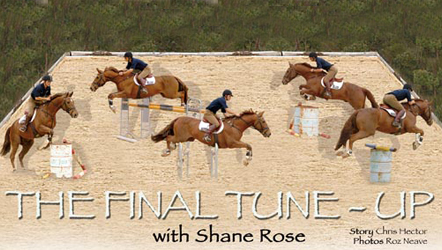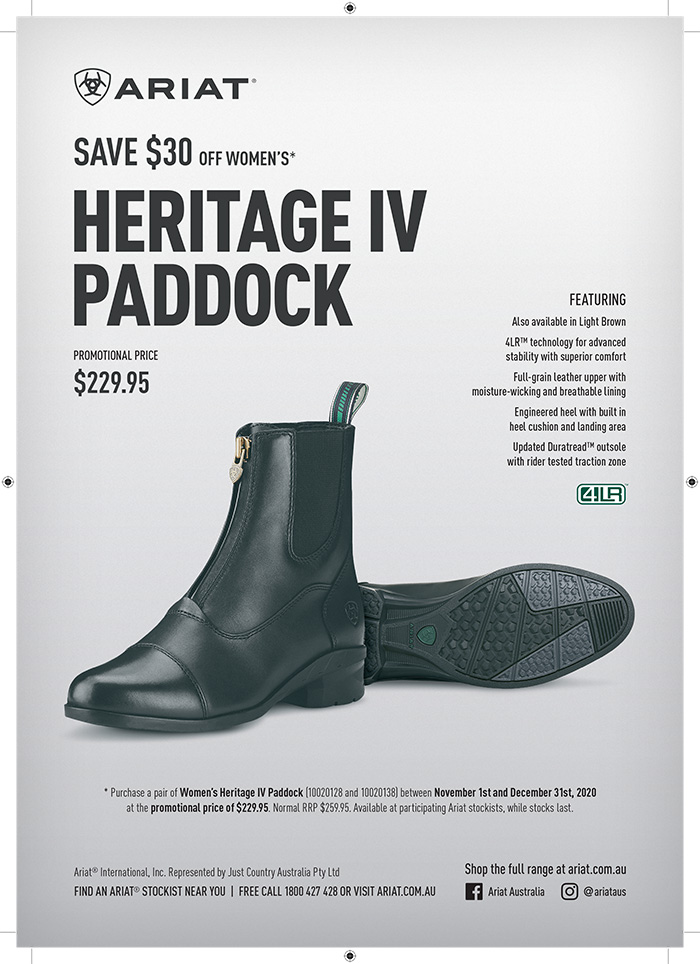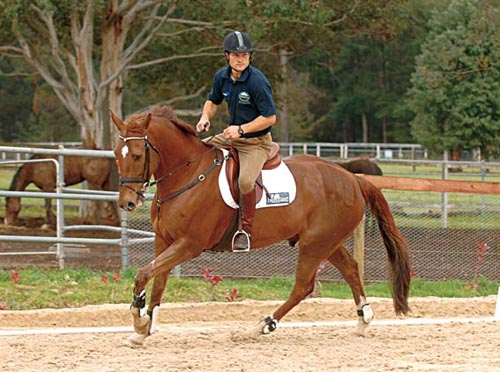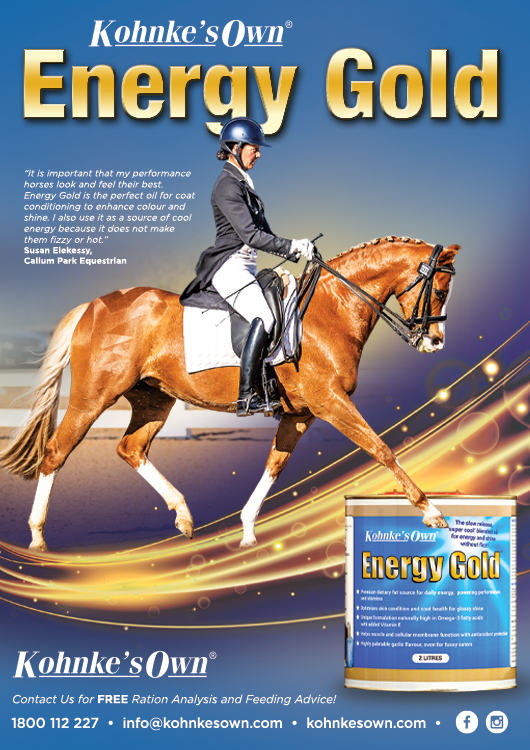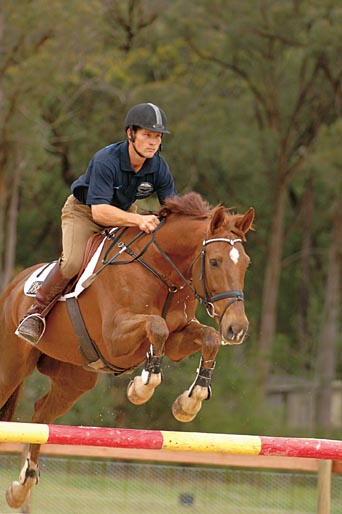Olympic eventer, Shane Rose talks about what you do in the last few days before heading to the event – at the time he was riding the Warmblood, Bobby Dazzler and headed for the two star at Sydney Three Day event…
Bobby Dazzler had been one of those unlucky horses that seems to have a whoopsie when he is just about to do something BIG. It was a relief for Shane Rose to head into the two star at Sydney 3DE with a trouble free preparation for the chestnut Warmblood (by the Contact son, Close Encounters). Four days out from the start of the event, Shane took time out to show what he tries to do in the crucial countdown.
Were there any problems that you needed to sort out?
“This horse is a very spooky horse. He struggles seeing new things for the first time. If I’m going to have trouble with him it will be at a scary fence, one where he’s just not sure he’s going to go, more so than a big fence.”
George Sanna says that’s a Warmblood thing. Warmbloods are visually spooked whereas Thoroughbreds are atmosphere spooked…
“I haven’t ridden that many Warmbloods but of the ones that I’ve ridden, I’d tend to agree with that. Probably the only one that wasn’t was Beauford Miss Dior. She was very Thoroughbred in everything she did. Today with Bobby Dazzler I didn’t use a cross rail – I don’t feel that it helps him produce a shape over a fence all that much. I just jumped a little vertical. I then added a couple of drums underneath that he hasn’t seen on the arena before. I felt that was going to be a little spooky for him and he was a little quick the first time. I rode him a little stronger and a little deeper, a little closer to the fence so that if he backs up, he’s not going to back up so far that it becomes an away distance or a chip. I want to try and get him a little closer until he becomes confident.”
Story continues below the advertisement
“The first two or three fences I tried to get a deeper distance until I get the feeling that he starts to jump up. What I mean by ‘jump up’ is, jump up through the wither. When he’s spooky, he tends to want to jump low. Some horses jump up in the air, he jumps low and slithers over the fence. To start with I get him deep to make sure that I get the right distance. I’d rather be a little deep than away when he’s spooking at the start. Once he becomes confident to jump the vertical, I would then get the distance more comfortable, maybe with a little more room.”
“I would work on that theory for warming up for show jumping on Monday. I will start to warm up and get him confident in the same way. Once we go into the arena, even though he’s quite tight in front, he’s quite good. If I get him too close sometimes he worries more about his front end and forgets about his back end. If he’s going to spook he goes low and has them down behind. As I go into the arena I will have him a bit strong into my hand, maybe a little more comfortable distance, not away, but with slightly more room than normal. I think of the many horses that are technically good in front, sometimes you tend to keep running them close to the fence because they bring their front end out of the way – quite often this makes them jump worse behind.”
“I then moved on to a little square oxer. On the vertical on both sides I have largish ground rails just to help him with his technique. The oxers I have more boxier, unless I want to get them to use their back end more. Then I’ll try with rising oxers but hopefully I will have done all that schooling in the previous week-and-a-half. Today was just tuning up, getting his muscles working in the right direction and re-affirming his skills.”
“I then started to test lots of different things for show jumping and cross country. I jumped fences, straight lines, curves, jumped fences on an angle. At first I gave him a good look at each approach, made wide turns, got square and as he got more confident, made the turns tighter, gave him less time to see each fence, just to make sure he keeps registering quicker and quicker. When I felt that he was jumping well enough, I introduced some drums.”
Story continues below the advertisement
“He is generally a very straight horse. I didn’t use an apex today because he’s normally very straight. When you can see a fence and have a good clear approach and he understands what he’s got to do, he’s never run out. On a couple of occasions I have had a glance off of angle rails where I have been a little slack in my preparation and not allowed him to focus on where he is going.”
“I then jumped the drums. I jumped the two drums with a rail on them to start. He was comfortable with that so I jumped him both ways, adding a little bit of an angle. When he was very confident jumping the drums, I then did the same thing I did with the first fence. As I started I got him quite close in front of the drum and as he got more comfortable, gave him a little more room. I then jumped the drums with one stride to an oxer but it doesn’t have to be an oxer.”
“At first I made it very clear where he was going. He jumped that quite well so I went from the oxer to the drum which was probably a little harder on him. He was focussing through the oxer to the drums at the back. The first time we jumped the combination he was panicking and got quick. In cross country when they hit the fences they don’t come down, so I wasn’t unhappy with his careful response. He’s been in trouble recently for not doing that. Although if that had been a show jumping round, he would have had a fence down. But for me, he’s an eventer and it wasn’t a bad reaction.”
“I then jumped the oxer until he jumped it with a bit of shape and roundness. He became careful and got up in the air. As he becomes more confident he is more careful. He’s generally a careful horse and if he has a fence down it’s because he’s not confident, because he’s spooky.”
“When he jumped that quite well I then made it a little tougher. I made it one drum and for him, I put a drum on both sides, a little tight the distance was, about fifteen yards, just a yard short in three strides. I knew he would try to run at it. I wanted to keep a feel of his mouth so that I could keep him straight. Generally with his jumping, I’m not sure if you’ll see it in the photos, I keep a little more contact on his mouth than my other horses. If you soften your hand and let him use the fence to back up, he struggles more with his technique. If I do support him he’s quite good technique-wise, so I generally ride him much more with a stronger contact and keep that contact stronger over the fence. Occasionally, I will soften my hand over the fence just to make sure that he is still keeping a shape. If he does, I know that he’s jumping quite well and confident.”
“Once he jumped that as well as I felt he was going to jump it, I opened the canter up more like a cross country type fence, galloping at the oxers a little. I then changed that up to jumping a couple on the angle, shorter distances, deeper distances, just to make sure that he’s thinking. I don’t want to go to an event having him jumping really well but not knowing that I haven’t tried all these things. He did all that reasonably well and I was happy with him.”
You’re not going to jump him now until cross-country day?
“No, I don’t think so. He’s been jumping really well for the last couple of months. I’m not as happy as I have been in the past with his flat at the moment. He’s only just coming back from a spell for an injury. He’s a horse who, the fitter and stronger he gets, the easier he is to ride. I’m only just getting him fit and strong enough, so I’ll work the Wednesday, Thursday and Friday on dressage. He may be doing his dressage on the Friday or Saturday, I’m not sure.”
How much warm up are you going to want before you do your cross country?
“I prepare for the three day events without steeple chase, exactly the same as I would for a one day event. I feel that the reason we got rid of the roads and tracks and the steeplechase was because it made them tired so I don’t believe that tiring my horse out is going to be of any benefit for me. I’ll be on them for about twenty minutes and most of that will be walk. I’ll have a little bit of a canter and a jump after I’ve got on and then I’ll just walk around until I’m ready to go. And then maybe as much for my benefit as them, jump a couple of fences before the cross country. That’s just a general thing with all my horses. With Bobby Dazzler, I’ll probably do a little more jumping just before I go. In the events that I’ve had trouble with him, it has been early on at spooky fences. Courses like Worrigee just recently and Goulburn last year have sunken roads and fences that you don’t see a landing early on. If there’s going to be a fence like that I want to have him feeling as though he’s seen enough jumps and is confident enough to jump if we get something scary early on.”

this article first appeared in The Horse Magazine in 2012

